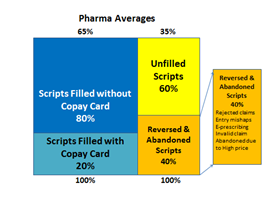We always find that there is confusion among brand team members when we talk about abandonment rates. Many people confuse abandonment rates with reversal rates and think they are one in the same… they are not!
Let me take you through the explanation of how each is calculated.

We start with the written scripts shown in Figure 1. Then, in Figure 2, we look at the pharma industry average of scripts which are filled vs. those that are not filled. Based on past studies that have been performed across all of pharma, we know that (on average) scripts are filled 65% of the time, which leaves 35% of scripts unfilled. As in Figure 3, a portion of the filled scripts utilize a copay card. This number is different for each brand depending on their offer and strategy.
Now, let’s examine the right-hand side of Figure 4 – the 35% of the equation which represents non-filled scripts. In many of these cases we just don’t know why the patient didn’t fill. There is no information here because the script was never presented to the pharmacy so there is no record and no reason. It could be that they never intended to fill the script. This group is 60% of the unfilled scripts. The rest of the time (the remaining 40% of unfilled scripts), we see an entry by the pharmacist into the NCPDP system and a reversal occurs for a variety of reasons:
- Rejected claims
- Entry mishaps
- E-prescribing script that was never filled (script automatically sent to pharmacy with no intent to fill)
- Invalid claim
- And about 30% of the reversals are actually the abandoned prescriptions (due to price). So that would be 30% of the 40% slice of the “unfilled” pie = 12.0% overall

So here you can see that abandonment rates are actually a subset of the reversal rates. If you are tracking reversal rates thinking they are a measure of abandonment, you are incorrect. You need to be able to break down the reversals into those due to abandonment (less than half of all “reversed scripts”) vs those due to other reasons. This will provide a more accurate read on the patients who presented to the pharmacy and abandoned their script there (probably due to a price issue).










